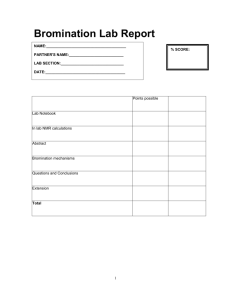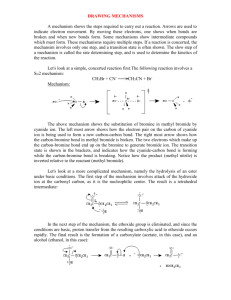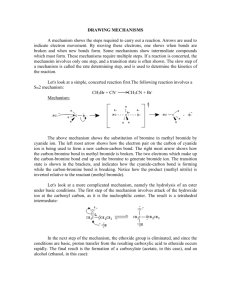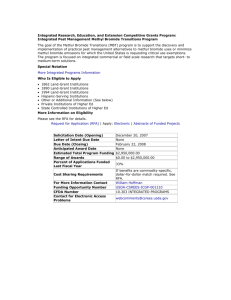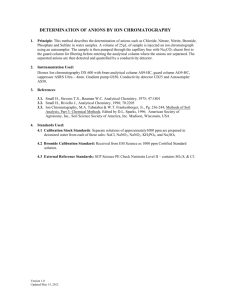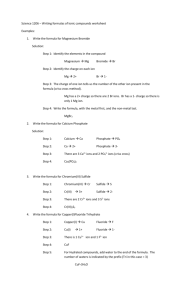Bromination Lab Report
advertisement
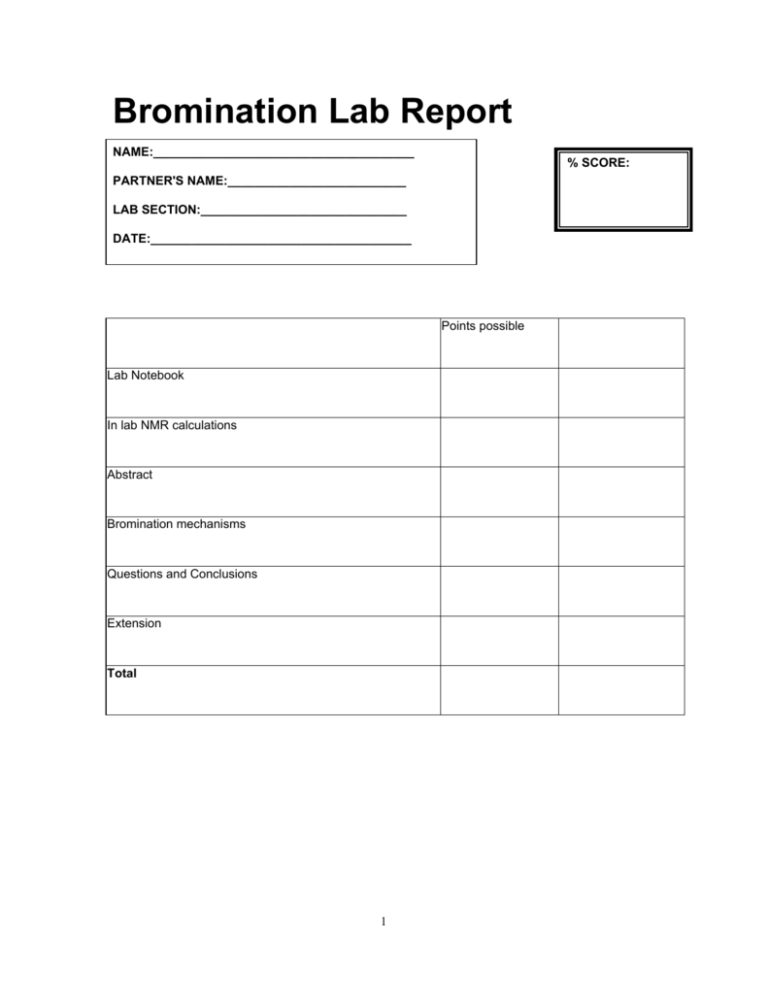
Bromination Lab Report NAME:______________________________________ % SCORE: PARTNER'S NAME:__________________________ LAB SECTION:______________________________ DATE:______________________________________ Points possible Lab Notebook In lab NMR calculations Abstract Bromination mechanisms Questions and Conclusions Extension Total 1 A. ABSTRACT: Bromination of trans-cinnamic acid 2 B. BROMINATION MECHANISMS - use structures Draw each proposed mechanism for the bromination of trans-cinnamic acid. Be sure to include 3-D structures of the products formed and assign R or S configurations to any stereocenters formed in the reaction. MECHANISM A: cyclic bromonium ion intermediate Step 1: Formation of intermediate Step 2a: Nucleophilic attack by bromide ion Step 2b: Nucleophilic attack by bromide ion* * Remember that the bromide can attack the other carbon atom of the cyclic bromonium ion as well. 1. What is the stereochemical relationship between the products of 2a and 2b? 3 MECHANISM B: planar carbocation intermediate Step 1: Formation of intermediate Step 2a: Nucleophilic attack by bromide ion † Step 2b: Nucleophilic attack by bromide ion † Remember that the bromide can attack the carbocation from the other side as well. MECHANISM B: planar carbocation intermediate ‡ Step 1a: Formation of intermediate Step 2c: Nucleophilic attack by bromide ion † Step 2d: Nucleophilic attack by bromide ion ‡ Remember that a second planar carbocation intermediate is possible. 2. Identify the stereochemical relationship between the products of: a. Step 2a and Step 2b __________________________________________ b. Step 2a and Step 2c __________________________________________ c. Step 2a and Step 2d __________________________________________ d. Step 2b and Step 2c __________________________________________ e. Step 2b and Step 2d __________________________________________ f. __________________________________________ Step 2c and Step 2d 4 C: QUESTIONS AND CONCLUSIONS 1. Complete the following Fisher Projections of all the possible dibrominated products for the reaction completed in this lab. O OH (2R, 3R ) Isom er A O OH O (2S, 3S ) Isomer B OH (2R, 3S) Isomer C O OH (2S, 3R ) Isomer D 2. Consider the two mechanisms proposed for this reaction. a) Which of the above stereoisomers would be produced if MECHANISM A occurred? b) Which of the above stereoisomers would be produced if MECHANISM B occurred? 3. Based on your melting point data, what can you conclude about the stereochemistry of the product of this bromination reaction? 5 4. Which of the proposed mechanisms is more consistent with the data collected in this experiment? Explain. 5. Does the coupling constant of the trans-cinnamic acid differ from the dibromide product? Are the calculated coupling constants consistent with the accepted values for trans alkenes and saturated systems? 6 D. EXTENSION. You have learned about the halogenation and hydration reactions of alkenes. These two reactions can be combined to form a halohydrin, a compound with a halogen substituent adjacent to a hydroxyl substituent. Although the reaction is easily followed by monitoring the solution's pH, the mechanism is somewhat counterintuitive. In this problem, you will use your knowledge of halogenation and hydration reaction mechanisms to explore this new reaction. Initial conditions (refer to beaker diagram below) 1. What is the organic reactant in this specific reaction? ____________________________ 2. What halogen is involved in the reaction? ____________________________ 3. What is the limiting reagent in this reaction? ____________________________ 4. What is the solvent in this reaction? ____________________________ 5. For this reaction to proceed at a reasonable rate, it must be stirred vigorously. Why is this required? First step 6. Which is more likely to be attacked by the alkene: a halogen molecule or a water molecule? Remember that no acid catalyst (e.g. H2SO4) is present. 7. Draw the first step of the mechanism by showing each curved arrow. 8. Sketch the results after the first step. Be sure to account for ALL atoms and ions. H O H O H H H H O O H Br Br H O H H Br H O H Br H H O O H Br H H O H Br H O H Initial conditions End of first step 7 Second step - 9. The second step involves a nucleophilic attack by either H2O or Br . Although bromide is the better nucleophile, it is less reactive than H2O in this system. Why is bromide a better nucleophile than H2O? 10. In a polar protic solvent such as water, good nucleophiles are strongly solvated. Sketch the solvation of bromide in this system. 11. Solvation by water substantially reduces bromide's ability to act as a nucleophile. Why does solvation have the effect of "turning off" a good nucleophile? 12. Draw the second step of the mechanism using structures and arrows. 13. Sketch the results after the second step. Be sure to account for ALL atoms and ions. End of first step End of second step 8 Third step 14. The third step involves a deprotonation of the oxonium ion. Which is the stronger base: H2O or bromide ion? 15. Draw the third step of the mechanism by showing each curved arrow. 16. Sketch the results after the third step. Be sure to account for ALL atoms and ions. End of first step End of second step Wrap-up 17. Write the chemical equation for this reaction. Does syn or anti addition occur? 18. Is the product a pure substance (non-meso), a mixture of enantiomers, a mixture of diastereomers, or a pure substance (meso compound)? 19. Describe how NMR data could be used as evidence to support that the halohydrin is the major product and not the dibromide. 9
